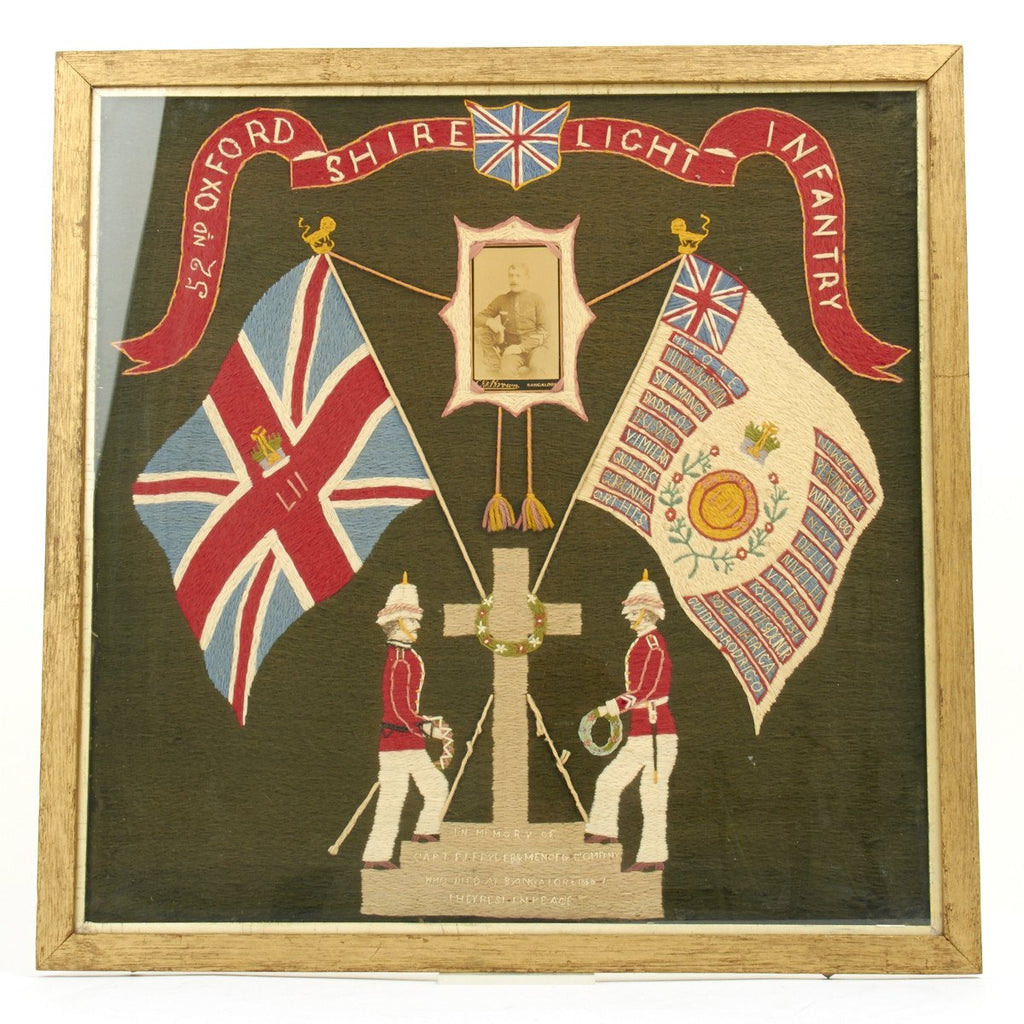Item Description
Original Item: One-of-a-kind. This terrific very vivid colored tapestry measures 24" square in its gilt wood glazed frame. It depicts two troopers of the 52nd Oxfordshire Light Infantry and a memorial to:
CAPTAIN P.J.F. PYLER & THE MEN OF "G" COMPANY WHO DIED AT BANGALORE 1886/87
Beautiful tapestry work showing the regimental colors and battle honors including Quebec, the Peninsula War and Waterloo as well as much service in India. This was one of Britain's great Infantry Regiments that always seemed to be "there".
In the center is a period studio photograph of Captain Pyler in uniform taken in Bangalore.
Offered in wonderful condition, with the troopers wearing spiked pith helmets. Most engaging.
History of the-
The Oxfordshire and Buckinghamshire Light Infantry was a light infantry regiment of the British Army that existed from 1881. In 1958 the regiment was renamed the 1st Green Jackets (43rd and 52nd) and formed part of the Green Jackets Brigade. In 1966 the battalion became the 1st Battalion The Royal Green Jackets which in 2007 was amalgamated into The Rifles.
The regiment was formed as a consequence of Childers reforms, a continuation of the Cardwell reforms, by the amalgamation of the 43rd (Monmouthshire) Regiment of Foot (Light Infantry) and the 52nd (Oxfordshire) Regiment of Foot (Light Infantry), forming the 1st and 2nd Battalions, The Oxfordshire Light Infantry on 1 July 1881.
In 1908, as part of the Haldane Reforms, the regiment's title was altered to become the Oxfordshire and Buckinghamshire Light Infantry, commonly shortened to the 'Ox and Bucks'.
Operations across the Empire (18811914)
1st Battalion
The 43rd Foot was based in Burma when it became the 1st Battalion. In 1882 the unit moved to Bangalore, India. In 1887 the battalion returned home, being based in Parkhurst, England. It moved to Kinsale, Ireland in 1893 and, having been based in other parts of Ireland, returned to England in 1898. In December 1899 the Second Boer War began and the 1st Battalion arrived in Southern Africa to take part in it. It saw extensive service in the conflict, including in the relief of the besieged British garrison at Kimberley and in the defeat of the Boers at Paardeberg in February. The war raged on for a further two years; the regiment saw extensive service for the duration of the conflict. The Oxfordshires returned to the UK in 1902 with the conclusion of the war. It moved to India the following year where it was based until the outbreak of World War I in 1914.
2nd Battalion
The 52nd Light Infantry was based in Oxford, England, when it became the 2nd Battalion. This was the 52nd of Waterloo fame who, under the command of Colonel Sir John Colborne, broke a battalion of the Chasseurs of the Imperial Guard. In 1884 it arrived in Gibraltar and the following year the battalion took part in active service for the first time as a 2nd battalion when a detachment under the command of Lieutenant Scott was deployed as mounted infantry in the Nile Expedition. In 1886 it was based in India, where it would remain into the 20th century. During its stay the battalion formed part of the Peshawar column in the Tirah Expedition in the volatile North-West Frontier in 1897. In 1903 the battalion returned home and was initially based in Chatham and in 1907 moved to Tidworth, Wiltshire. The battalion was stationed at Albuhera barracks, Aldershot, when World War I commenced.
- This product is available for international shipping.
- Eligible for all payments - Visa, Mastercard, Discover, AMEX, Paypal & Sezzle















